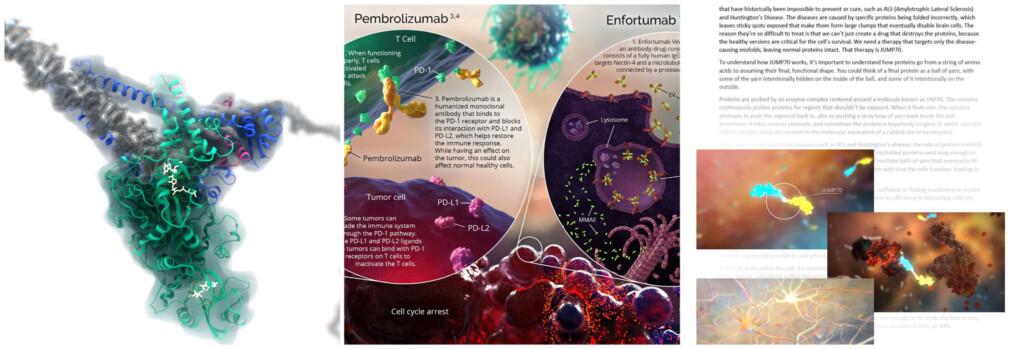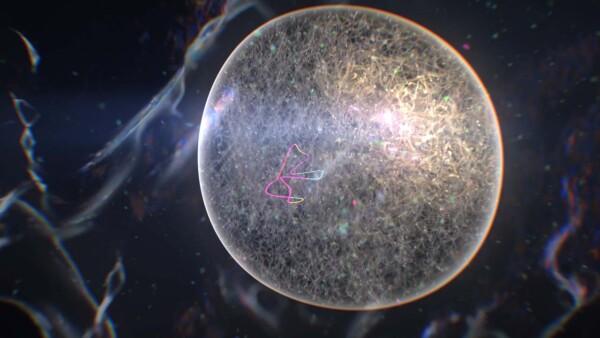
What Should Scientific Animation Cost?
By: Cameron Slayden
Note: This is a duplicate article for those searching for scientific animation rather than 3D medical animation. For all intents and purposes, both refer to the same type of animation and are therefore priced identically. If you would like to see that article instead, click here.
How Much Does Scientific Animation Cost Per Minute?
In the scientific animation industry, the cost of a project is typically quoted on a per-minute basis.
TLDR: Microverse Studios charges $35,000-45,000 for a one minute animation, $55,000-65,000 for a two minute animation, and $75,000-$105,000 for a three minute video. A 30-second production would range from $25,000-30,000. The per-minute rate decreases as duration increases. The range represents varying prices due to project complexity. As you can imagine, more complex stories require more work hours to complete.
Our predictable pricing covers all aspects of scientific animation production from start to finish. We have highly accurate metrics that allow us to predict and maintain scope. These are outlined later.
Why Do We Charge So Much?
In the scientific animation landscape, you'll see a variety of price points, with our rates squarely in the middle (despite our commitment to top-tier production quality).
We are able to provide complex, scientific animation at a mid-range price point thanks to our streamlined workflow and minimal overhead. We cannot charge the lowest rates, however, because high production quality and scientific accuracy requires top talent.
Every member of our creative staff is both an award-winning filmmaker, and has a masters' degree in medical illustration. This means that the animators at our studio have the scientific background to completely understand your science and the creative chops to produce award-winning animation for every project.
How Do Some Scientific Animation Studios Charge Less?
Imagine the process of scientific animation production as being like building a house. The experience and dedication of the team you choose determines the quality of the end product. If you're building a shed, cheap out. There is no need to source the finest building materials or the most exclusive architect. If you're building a sleek mansion, that’s a bit different. Choose your team wisely!
To be able to charge a lower price point, other studios need to pay their animators less. This could mean using freelancers, outsourcing overseas, or hiring animators without advanced degrees or scientific knowledge.
For some less complex stories or stories that have more to do with CAD files and engineering, this isn't an issue. If your story is full of intricate scientific detail, you will need to decide up front how rigorous the science in your animation needs to be.
If you cannot skimp on complexity, then you will need to determine how much time your team has to explain the science behind your new technology and to correct any scientific errors that may pop up.
How Can Early Stage Startups Afford Scientific Animation?
Microverse Studios serves early stage biotech startups, larger pharmaceutical clients, and the agencies that cater to them.
We know that, for very early startups, cash flow can be complicated. We always seek to make our work available to everyone that needs it. We have had success deferring payments until after a raise is complete, providing long term payment options, and accepting partial payment in the form of equity (via SAFE note).
How Do We Determine Project Scope for a Scientific Animation?
We've found that the best predictor of the quantity of labor in a given project takes into account three variables: script word count, optimal pacing, and concept count.
These provide a consistent metric for scoping any animation because they're rooted in how the brain works. Let’s take a look at these variables now.
Script Word Count
When we write our scripts, we keep in mind that, in English, narration is read at about two words per second. We don't use word count as a rigid metric, because the verbiage needed to communicate each concept can vary widely, but it does provide some guide rails that can keep script edits from driving scope creep.
As a general rule, don’t expect an animation to be shorter than the time it takes to read it aloud, or about 120 words per minute. Pro tip: the brain can only read as fast as it can understand speech, so this includes text on screen!
Optimal Pacing
It takes about 10 seconds to move a piece of information from short term memory into working memory. In working memory, ideas are strung together into a narrative. If presented too quickly, short term memory will dump a piece of information to make room for the next. If presented too slowly, working memory will have a hard time sequencing them.
We always add a second on either side of each concept to account for smooth transitions, so that means that in sixty seconds you can fit about five concepts at the perfect pace for learning.
Concept Count
Your scientific animation will have a certain number of discrete ideas that the audience must understand before it ends. Pro tip: Knowing this, you can predict and tailor the duration of your own project before you talk to your first scientific animation studio!
The hard rules of cognition make concept count the central metric for predicting how long an animation must be.
Because we know how much work goes into making a given concept come to life on screen, this also gives us a very accurate predictor for establishing project scope.
How Can I Minimize the Cost of My Project?
Be concise. Certain elements will be critical to your story, but know the difference between what needs to be demonstrated in animation versus what can be a text box displayed alongside it. Always remember that animation is best served by stories that “show” rather than “tell.”
Expository elements such as long lists of features or applications might even have better impact elsewhere on the webpage, remaining in view longer than if they are included in the animation.
Cost Breakdown in Scientific Animation
As we see it at Microverse Studios, every scientific animation has two cost components: pre-production/overhead and animation production.
Scientific Animation Pre-production/Overhead
Every project takes a certain amount of overhead, regardless of final video duration. This includes time spent working on things like research, meetings, internal review, creative direction, and production management. It also includes script writing, our unique style development protocol, concept art, and storyboarding.
Because this workload is very consistent, we have a standard line item of $15,000 for most scientific animation projects.
Scientific Animation Production Costs
Here, scientific animation production refers to creating the actual 3D animation. This includes geometry, programming, rigging, keyframing, camera work and so forth. It also includes using supercomputing resources, rendering, compositing, video editing, and professional voice.
This second component represents the bulk of costs associated with production, and scales with video duration. The cost is dependent on the anticipated work to create the imagery up to Microverse Studios' standards for production value.
For example, if an animation takes place in multiple microenvironments (i.e. kidney, lung, liver, etc.), each of these environments must be built from scratch. Part of our value is that we reuse very few materials from one animation to another, ensuring that every project is unique. This added research and work drives the cost difference for more complex projects.
This production line item ranges from $20,000 to $30,000 per minute of finished animation. The range reflects variations in project complexity.

Other Scientific Communication Services
We produce more than animation! We also provide scientific and medical illustration for print and web, plain language medical writing for investor outreach, immersive experiences for your next conference booth, VR and 360 video and more. We even sweeten Powerpoint presentations.
Because the production process for each of these services can vary significantly, they are typically priced differently from scientific animation. Medical illustrations, medical writing and Powerpoint presentations, for example, would not require per minute pricing. Often, in these cases, we use our day rate of $2,000.
Frequently, one kind of project dovetails into another. For example, illustrations in one year might be expanded into animations the next. We take into account work already done on a project when building expanded scopes in order to optimize our clients bang for their buck.
If you'd like to find out more about our scientific animation or the other services we provide, reach out! A quick, 15-30 minute call is usually all we need to discuss the best possible means of scientific communication for your technology (or whether your project even requires our services in the first place).
Our philosophy is to be transparent about our pricing structure, and to always keep our clients’ best interests at heart while serving their unique needs. We always counsel toward brevity and act as thought partners to make their stories as successful as possible. We have found this to be the best business strategy because it keeps our clients coming back again and again.
You might also like

Cameron Slayden is CEO of Microverse Studios, and has over 20 years of experience in biomedical visualization. To find out more, check him and the rest of our team out on the Who We Are page.



